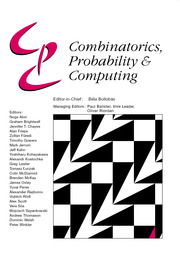Crossref Citations
This article has been cited by the following publications. This list is generated based on data provided by
Crossref.
2011.
Volume Removed - Publisher's Disclaimer.
Energy Procedia,
Vol. 13,
Issue. ,
p.
1.
Bolla, Marianna
2011.
Penalized versions of the Newman-Girvan modularity and their relation to normalized cuts andk-means clustering.
Physical Review E,
Vol. 84,
Issue. 1,
Awasthi, Pranjal
and
Sheffet, Or
2012.
Approximation, Randomization, and Combinatorial Optimization. Algorithms and Techniques.
Vol. 7408,
Issue. ,
p.
37.
Pak, Igor
and
Vilenchik, Dan
2013.
Constructing Uniquely Realizable Graphs.
Discrete & Computational Geometry,
Vol. 50,
Issue. 4,
p.
1051.
Fishkind, Donniell E.
Sussman, Daniel L.
Tang, Minh
Vogelstein, Joshua T.
and
Priebe, Carey E.
2013.
Consistent Adjacency-Spectral Partitioning for the Stochastic Block Model When the Model Parameters Are Unknown.
SIAM Journal on Matrix Analysis and Applications,
Vol. 34,
Issue. 1,
p.
23.
Abbe, Emmanuel
and
Montanari, Andrea
2013.
Approximation, Randomization, and Combinatorial Optimization. Algorithms and Techniques.
Vol. 8096,
Issue. ,
p.
332.
Krzakala, Florent
Moore, Cristopher
Mossel, Elchanan
Neeman, Joe
Sly, Allan
Zdeborová, Lenka
and
Zhang, Pan
2013.
Spectral redemption in clustering sparse networks.
Proceedings of the National Academy of Sciences,
Vol. 110,
Issue. 52,
p.
20935.
Feldman, Vitaly
Grigorescu, Elena
Reyzin, Lev
Vempala, Santosh
and
Xiao, Ying
2013.
Statistical algorithms and a lower bound for detecting planted cliques.
p.
655.
Abbe, Emmanuel
and
Montanari, Andrea
2013.
The mutual information of a class of graphical channels.
p.
20.
Lelarge, Marc
Massoulie, Laurent
and
Xu, Jiaming
2013.
Reconstruction in the labeled stochastic block model.
p.
1.
2013.
Spectral Clustering and Biclustering.
p.
96.
Dughmi, Shaddin
2014.
On the Hardness of Signaling.
p.
354.
Massoulié, Laurent
2014.
Community detection thresholds and the weak Ramanujan property.
p.
694.
Chen, Yudong
Sanghavi, Sujay
and
Xu, Huan
2014.
Improved Graph Clustering.
IEEE Transactions on Information Theory,
Vol. 60,
Issue. 10,
p.
6440.
Angelini, Maria Chiara
Caltagirone, Francesco
Krzakala, Florent
and
Zdeborova, Lenka
2015.
Spectral detection on sparse hypergraphs.
p.
66.
Mossel, Elchanan
Neeman, Joe
and
Sly, Allan
2015.
Consistency Thresholds for the Planted Bisection Model.
p.
69.
Mossel, Elchanan
Neeman, Joe
and
Sly, Allan
2015.
Reconstruction and estimation in the planted partition model.
Probability Theory and Related Fields,
Vol. 162,
Issue. 3-4,
p.
431.
Lelarge, Marc
Massoulie, Laurent
and
Xu, Jiaming
2015.
Reconstruction in the Labelled Stochastic Block Model.
IEEE Transactions on Network Science and Engineering,
Vol. 2,
Issue. 4,
p.
152.
Lei, Jing
and
Rinaldo, Alessandro
2015.
Consistency of spectral clustering in stochastic block models.
The Annals of Statistics,
Vol. 43,
Issue. 1,
Cheng, Yu
Cheung, Ho Yee
Dughmi, Shaddin
Emamjomeh-Zadeh, Ehsan
Han, Li
and
Teng, Shang-Hua
2015.
Mixture Selection, Mechanism Design, and Signaling.
p.
1426.

